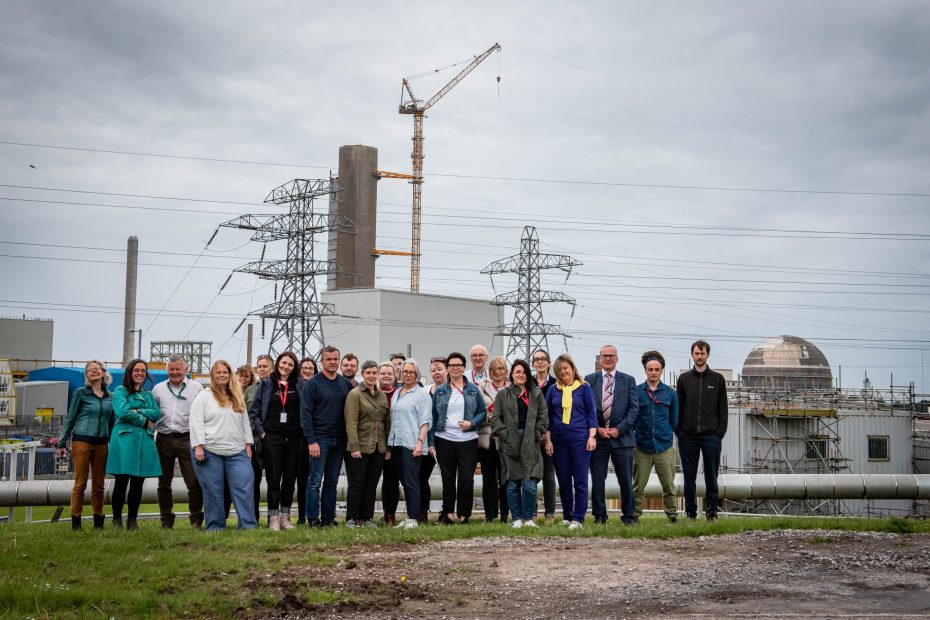Head guide of Energy and Technology Museum Žilvinas Mikulėnas participated in the nuclear cultural heritage project “NuSpaces” in May and visited the Sellafield nuclear site and the Low Level Waste Repository in Great Britain.
The meeting marked the beginning of the project “Nuclear Spaces: Communities, Materialities and Locations of Nuclear Cultural Heritage”, and it was attended by representatives of universities, museums, municipalities from Great Britain, Sweden and Lithuania.
Project coordinator is Kingston University Professor Dr. Eglė Rindzevičiūtė. The initiators of the project emphasize that due to the decommissioning of nuclear power plants (NPPs) in many European countries, challenges arise due to the shutdown of the power plants themselves, the storage of nuclear waste, and at the same time a new area of culture, nuclear heritage, is being found. It is not clearly defined what nuclear cultural heritage is, how it can be useful for various social groups, there is a risk of losing valuable tangible and intangible forms and values of nuclear cultural heritage. The project’s working group aims to answer these questions and outline guidelines for nuclear facility preservation practices.


Sellafield nuclear site.
Nuclear heritage
On May 17-19 project participants Linara Dovydaitytė, a lecturer at Vytautas Magnus University, head of the Lithuanian delegation, representatives of Visaginas Municipality, Visaginas Tourism Development Center, Ignalina NPP and the guide of Energy and Technology Museum (the first public power plant of Vilnius) Mikulėnas gathered at Sellafield nuclear site.
“We have to demolish the polluted NPP buildings, but we want to preserve their history. Colleagues from well-known museums (Malmo, Tekniska, London Science Museum) and the employees of the institutions responsible for the closure of the NPP discussed how to define the nuclear heritage. We have only one such facility in Lithuania, Ignalina NPP. We haven’t closed it yet, so these challenges are just waiting for us in the future. Meanwhile, other countries, such as Britain, have long grappled with the question of how to preserve nuclear history. The group of researchers formed during the project collects information about the first examples or beginnings of such practice. By defining what nuclear cultural heritage is, NPPs and the authorities managing their closure will make it easier for museums to take over and preserve nuclear heritage objects,” said Mikulėnas.


On the left shows how spent fuel is stored.
Green meadow
Ignalina NPP was shut down on December 31st 2009, and according to the decommissioning plan, it will be finally closed by 2038. Currently, the NPP is being dismantled, radioactive materials are being sorted and inventoried. The final goal of dismantling the NPP is a green meadow on the site of the former NPP.
“The Ignalina NPP will be demolished to its foundations, and a deep storage will remain underground (currently, a study is being conducted on where it could be built). We will not place fuel cartridges in the museums. We took a picture with the project participants at the Sellafield nuclear site. This is the world’s first round building. Unfortunately, it cannot be saved due to the heavily contaminated reactor inside. However, depending on the pollution and the available finances, it is possible to save part of other objects of the power plant for future generations”, said Mikulėnas.
The Sellafield nuclear site also housed a Visitor Center, which used to be visited by more than 250,000 people a year. “It is said that it was very interesting. After September 11 attacks in 2001, it was forbidden to bring visitors to the NPP, the flow of arriving people decreased until the center finally closed. In the Beacon museum one floor is dedicated to the history of Sellafield – a new exhibition space has been created here. The Science Museum in London is also hosting an exhibition on nuclear heritage. But what to show and exhibit? This question arises for colleagues in different countries,” the interviewer continued.


Žilvinas Mikulėnas presented Energy and Technology Museum.
Myths and mystique of NPPs
What are Lithuania’s needs in the context of this project? “This meeting is the first, and the project is long-term. This year, we just started building the foundations. We know that the simulator of the control unit, where future engineers were trained, will remain from Ignalina NPP. It is a separate object. We would like to preserve the unique chimneys of the Ignalina NPP, but they are also the most polluted”, said Mikulėnas.

It is not known or decided who could finance the preservation and adaptation of NPP objects for display. Great Britain has a Nuclear Decommissioning Authority, which oversees more than 20 nuclear facilities, their successful decommissioning and heritage preservation.
It is also not foreseen where the preserved objects could be exhibited – in existing museums or new ones would be built. Would such a museum or exhibition be popular in Lithuania? “After the HBO series “Chernobyl”, the number of visitors to the Ignalina NPP increased significantly. NPPs are both authentic and exotic objects, specially protected, not everyone can visit them. Entire settlements are built for them. Power plant workers cannot discuss their work with family members, neighbors, or other residents of the town. Their activities, nuclear energy itself, are mystified and shrouded in myths,” Mikulėnas noted.
What did the guide of Energy and Technology Museum learn on this trip? “I grew professionally and personally. I learned a lot about nuclear energy, I took practice, advice and ideas from professionally senior colleagues. Finally, West Cumbria is a very beautiful region,” said Mikulėnas.
Next year project participants will gather in Sweden. In 2024, Swedish and British delegations will visit Lithuania, Ignalina NPP.


“The Atom a Love Affair” movie review.

